We seldom talk about it. We usually don’t show it off. But it’s always there. And sometimes, it’s interesting and educational to look at it.
It’s the Backside of Hand Embroidery.
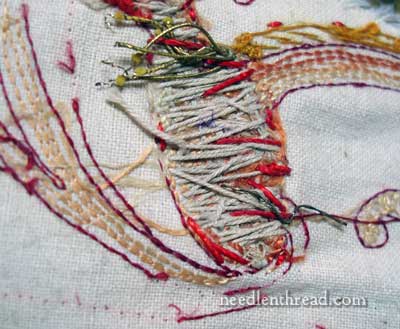
When you look at The Other Side of Hand Embroidery, you’re not usually looking at it from its best angle!
Many of us probably had a mentor at some point – a grandmother, an aunt, a teacher – who told us that the back of our embroidery should look as good as the front.
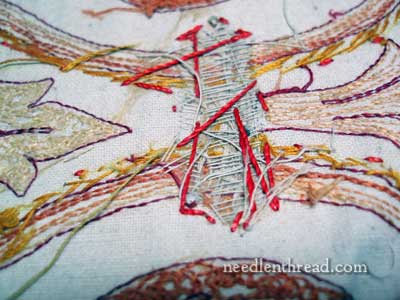
To that, I say Pshaw! Except in the case of reversible stitching, the fact o’ the matter is this: the back never looks as good as the front!
Sure, you should strive to keep it neat and tidy. You don’t want threads getting all confused and tangled back there. You don’t want trails of threads showing through the front. You don’t want massive heaps of knotty messes that cause your work to bulge unattractively.
But other than that… As good as the front? Mmmmmm….. I don’t think so.
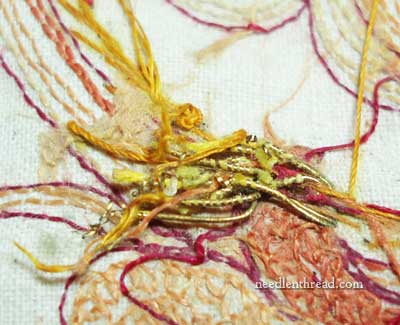
It’s just not reality. In normal cases of regular surface embroidery, the back simply doesn’t look as good as the front.
In the photo above, the gold threads from the front of the embroidery have been sunk to the back. But they haven’t been anchored. No neat over-stitching there. Over time, the ends have become a bit of a jumble. This is not a route I’d go, necessarily… but it has been done often. I’ve scoured over the backs of many an old piece of superb ecclesiastical work where the gold threads end pretty much just like this.
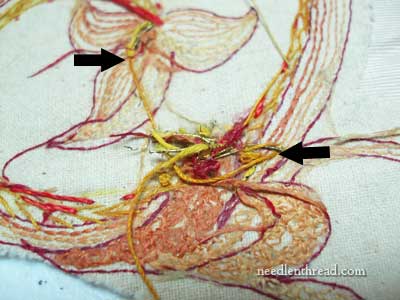
See the arrows in the photo above? They point to two ends of one strand of silk thread, carried all that distance, and caught up in a jumbled mess of sorts where some gold threads are sunk and the silk threads have been ended.
Don’t get me wrong – I’m not offering an excuse for poor habit development! My approach to The Other Side is generally this: try to keep it neat and tidy, but don’t obsess over it.
After all, if the back of your embroidery looks as good as the front of your embroidery, it probably took you ten times longer to do it, and gave you about half the pleasure.
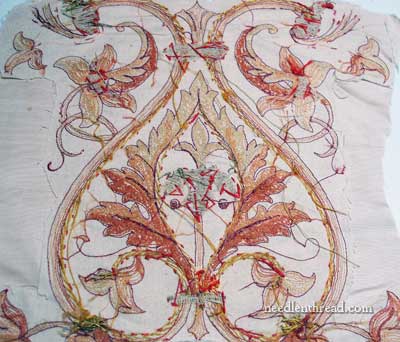
So in case you’re struggling with feelings of inadequacy because the back of your embroidery isn’t picture perfect, this old piece of embroidery – which features some fairly advanced embroidery techniques, so we know it wasn’t worked by a novice – should dispel any misgivings!
Stitch on, people! Stitch on!







Thanks, Mary! It’s always nice to be given permission to be relaxed about something meant to bring beauty and the pleasure of accomplishment into our lives.
So goes the old analogy of life we see it from the back side and God sees it from the front!!
I agree completely. After all, the back of our work is rarely seen. And what is more, those small imperfections we see when we are stitching are unlikely to be noticed, as very few people will ever look as closely as we do.
Someone once told me that nothing we make should be absolutely perfect, in case someone would think it is made by machine!
Mary, You brighten my day and make me smile! You are so right if one obsess over the back you loose half the pleasure of stitching.
My husband and I travel by RV and my love of embroidery fits our traveling life style. One of the things I enjoy is visiting needlework shops in many different towns, and I often mention your web site to the ladies in the store and tell them how wonderful it is and how many great ideas they will get from you.
Thank you for…..well everything!
Thank you for this. Mom never said the back should look as good as the front but over the years I did here this and it bothered me.
One thing I always find hard to find is information on how to begin and end stitching. Knot? No knot? Stitch in place a couple of times? Bury your ends?
Thanks Mary! Do you have any suggestions for the backside of embroidery on napkins and cup towels? I love to dress up my napkins but never quite know what to do with the backside since it shows nearly as often as the front when used. I would love to know if anyone has come up with some clever ideas. Thanks, Carolyn
Exactly! Why should an embroidery look the same from the back as it does from the front? Everything has two sides, most of the time not identical. I know that I myself look different front and back, and I’m glad I do.
Having said this – I definitely like to look at the backsides of embroidery. They have a beauty of their own, for instance revealing the working rythm that does not necessarily show on the front.
Thanks for this liberating und fun article!
Thanks Mary, I feel so much better. The last time I gave Embroidery as a gift, the person turned it over & asked if the back looked as good as the front (which it didn’t, of course)
This made me reluctant to give any more as gifts. Its time that outdated notion went away. Thanks for helping to dispel this myth.
Mary, thank you for liberating me from my guilt. I always thought stitching was a form of relaxation and enjoyment.
Thank you!! I have taught embroidery for many years, and there is always someone in class that insists that their back look exactly like the front. I’m with you–if it can be easily woven in, then do it. If not, roll with it and have enjoy the process–isn’t that why we are embroidering in the first place?
Karen in Breezy Point
moosebaymuses.blogspot.com
Hi Mary-
Thank you, thank you, thank you! I have been obsessing (a little) over how the back of my work looks for years, and you’re right – it takes me twice as long to stitch, and it’s half the fun! I once gave a set of stamped embroidered baby bibs to a new mother, and the first thing she did was turn my work over and look at the back! Needless to say, she didn’t get more handmade gifts from me. From now on, I will stitch to enjoy the process, and stop being such a perfectionist!
Thank you! It’s so good to know I’m not alone. I was taught to embroider by my Grandmother. She had told me the same thing “the back should look as good as the front”. Hers did, mine NEVER has.
THANK YOU!
I struggle with how to keep neat the back of my work especially when I work with over 30 colours in 7×7 piece, and I have always wondered what the backs of older pieces looked like. So, Thanks for soothing my inner perfectionist and Thanks for satisfying my curiosity.
Techiya
Wow! This one blog…my whole world has opened up! Years of inadequacy – erased! Kinda sounds silly, doesn’t it? A perfect stranger needing to set me free? But you have. 🙂
While I try to make the backs neat (no lumps/knots/tangles or long carries that show through) as possible, I gave up fussing a long time ago. Quilters have a couple of sayings I like – “done is better than perfect” and “if you can’t see it on a galloping horse at thirty paces it doesn’t matter”. I also quit pointing out mistakes in things I make.
I’m fairly certain Mary did have some pointers about starting and stopping a while back, but don’t recall if it was a separate post. I do recall pinstitches where they’d be covered by the embroidery, and weaving the tails through the back of the stitching. Those have made a huge difference for me.
That is a beautiful piece of embroidery. I agree that there is no point to making the back as beautiful as the front – ridiculous. If you have no threads showing through, that is fine.
I will move from one small place to another if it is not far away. It is more secure to do that than to try to secure the beginning and end of a new thread for a couple stitches.
Thanks Mary! Great perspective. 😀
Wise words – don’t obsess about the back if it’s not going to be shown! So long as what’s on that side doesn’t spoil the front (lumps, puckers, show-throughs), it’s good enough.
Regarding things like table linen where the back will be often on show, the time to think about that is right at the design stage. Choose stitches that have attractive reverse sides and/or those that give plenty of places to hide thread ends. (I make unlined boxes, and have learnt to use stitches that cover the canvas at the back and give me lots of hiding places.) Part of the fun of designing for embroidery is taking into account the basic practical things like the amount of wear and washing something will receive, or whether the back will be on show, and turning that practicality into something attractive and interesting to stitch.
Dear Mary
Thanks so much for this post. Relief, Relief, phew thank goodness I’m not the only one. Every time I start a new project I strive to keep the back as neat as the front but alas! it never works out like that. Thank you Mary for showing us guilt ridden stitchers that even seasoned embroiders backs are not perfect.
Regards Anita Simmance
What a wonderfully encouraging item, I am still ‘bound’ up with trying to get the back of my stitching as good as the front, as a result of ‘old’ teaching. I fail miserably of course, so thanks for the encouragement.
Beryl
Hi Mary…
I truly don’t obsess but the back of my work tends to the tidy side. My brain thinks ahead of my needle…is how I describe it.
The negative side to this is all the work I do on the front…the side I want people to see…sometimes is missed as they will catch me in the process of burying a thread and think that is the right side!
I recently had a needlepoint piece of finishing come back … you guessed it…wrong side out. I took this laughing but the finisher was mortified. Still makes me laugh.
My mom told me that & refused to accept them as gifts from me. Oh well that’s her issue. My back are neatly organized & always covered with pillows or quilting and never seen anyway.
Needlework is my passion.
KK
Apart from anything else, it just isn’t possible to look the same at the back. Very many stitches have an entirely different look at the back. Chain stitch and back stitch for two. So it never will look the same at the back. It’s a shame anybody ever planted the idea that it should. It shouldn’t because it couldn’t. It’s not even about imperfections. Despite our very best efforts it won’t look that great. Yet here we are still thinking it’s something we should ideally aim for. The best seamstress in the world couldn’t manage it.
But yes, that’s different from having it look relatively neat. Myself right now, I’m wondering if knots are as bad as the alternative – lots of little fluffy ends that get dragged through to the front or at best just stick out at the back (This happens when you do tiny little stitches to start off. Maybe I should sew over them as well.
I’m really sad reading these comments. People looking at the back of gifts?! And people still feeling guilty because the back looks different. Of course it does!!!
That’s all well and good, but what if I’m wanting to make napkins or hankies? I don’t the back side looking like a tangled ball of thread. How do people conceal these stitches? I know they do because I have some vintage hand done hankies that there are NO stitches on the “wrong” side of the hankie.
Well, if they’re worked in white-on-white, you might not notice the stitches, because they’re probably pretty fine. But check the hankie – are there two layers of fabric, one covering up the other? On vintage hankies, you don’t normaly see two layers of fabric, unless it’s decorated with Madeira appliqué with pin stitching. Even then, you’ll still see the pin stitches if you look closely – although they’re hard to see if they’re white on white. Anyway, on household linens and the like, my backs are normally exposed, unless the piece would be something that’s normally got a lining or made from two layers. But for most tablecloths, towels, linen table runners, doilies, etc., this isn’t normally the case.
I don’t like to be a dissenter, but I have to disagree Mrs. Corbet! My Grammy is definitely on “The back must be as *neat* as the front” side of the argument, and I do what I’m told! She’s never impressed on me that the back must be the SAME as the front. That, as you said, is ridiculous. However, when it comes to neat stitching, yes she was strict. Now, of course she regrets being strict because my backs look neater than hers, but like I said, I do what I’m told!
I also like to give her bragging rights to her friends in her retirement community! 😀 So for me, I’ll continue to be obsessed with my “back side.
I agree it should be neat. But I don’t think it’s something that should be obsessed over. Often, obsessing over a perfect back can turn especially beginners off embroidery completely. For example, my niece had a teacher in school (home ec) who made the students pick out if the back wasn’t perfect. They didn’t get very far, and found embroidery frustrating and tedious. In such cases, turning a kid completely off embroidery over the back of the work just isn’t worth it, in my mind. Yes, neat. Obsessively neat? Not necessary. It should be neat enough that it doesn’t interfere with anything in the finishing (no trails, no threads carrying across empty spaces where they can be seen, no bulky knots, etc.). If the back is exposed (for example, on table linens), neatness is even more important. But perfection on the back is not essential – especially if you’re worrying more about the back than the front!!
Well, in such cases I’d question the method of teaching the lesson rather than the lesson itself. My Grammy never made me feel bad, or inadequate, and certainly never let me get so frustrated that I’d quit! But everyone is different.
Myself, by nature I’m an obsessive perfectionist. I find it hard to let go of details. So, the extra work is a pleasure for me. Others, are more laid-back. In the end, its all what’s best for the student!
Bless you for your bravery! You are the only stitcher who has posted photos of the dark side! I want to do dishtowels as thank you gifts but was concerned about the back1. YOU HAVE GIVEN ME COURAGE! Lol, thanks!